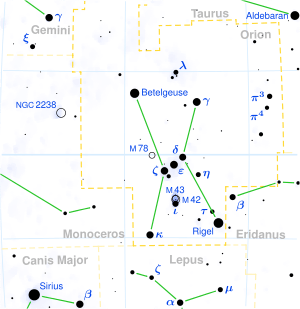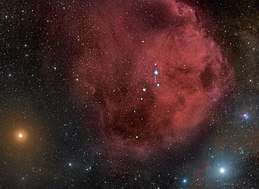Meissa
 | |
| Observation data Epoch J2000 Equinox J2000 | |
|---|---|
| Constellation | Orion |
| Right ascension | 05h 35m 08.27761s[1] |
| Declination | +09° 56′ 02.9611″[1] |
| Apparent magnitude (V) | 3.33[2] (3.54 + 5.61)[3] |
| Characteristics | |
| A | |
| Spectral type | O8 III((f))[4] |
| U−B color index | –1.01[5] |
| B−V color index | –0.21[5] |
| B | |
| Spectral type | B0.5 V[5] |
| U−B color index | –0.77[5] |
| B−V color index | +0.04[5] |
| Astrometry | |
| Radial velocity (Rv) | +30.10[6] km/s |
| Proper motion (μ) | RA: –0.34[1] mas/yr Dec.: –2.94[1] mas/yr |
| Parallax (π) | 2.97 ± 0.55[1] mas |
| Distance | approx. 1,100 ly (approx. 340 pc) |
| Absolute magnitude (MV) | –4.25 / -1.94 |
| Details | |
| A | |
| Mass | 27.9 ± 3.3[7] M☉ |
| Radius | 10.0[8] R☉ |
| Luminosity | 165,000[5] L☉ |
| Surface gravity (log g) | 3.90[9] cgs |
| Temperature | 37,689[9] K |
| Metallicity [Fe/H] | 0.03[9] dex |
| B | |
| Mass | 10.3 ± 0.7[10] M☉ |
| Radius | 4.2 ± 0.8[10] R☉ |
| Luminosity | 6,300[10] L☉ |
| Surface gravity (log g) | 4.21 ± 0.10[10] cgs |
| Temperature | 25,400 ± 500[10] K |
| Age | 1.8[10] Myr |
| Other designations | |
| A: HD 36861, HR 1879 | |
| B: HD 36862, HR 1880 | |
| Database references | |
| SIMBAD | λ Ori |
| A | |
| B | |
Meissa, designated Lambda Orionis (λ Orionis, abbreviated Lambda Ori, λ Ori) is a star in the constellation of Orion. It is a multiple star approximately 1,100 ly away with a combined apparent magnitude of 3.33. The main components are an O8 giant star and a B-class main sequence star, separated by about 4".
Nomenclature

Lambda Orionis is the star's Bayer designation. The traditional name Meissa derives from the Arabic Al-Maisan which means 'The Shining One'. Al-Maisan was originally used for Gamma Geminorum, but was mistakenly applied to Lambda Orionis and the name stuck.[11] In 2016, the International Astronomical Union organized a Working Group on Star Names (WGSN)[12] to catalog and standardize proper names for stars. The WGSN's first bulletin of July 2016[13] included a table of the first two batches of names approved by the WGSN; which included Meissa for this star. It is now so entered in the IAU Catalog of Star Names.[14]
The original Arabic name for this star, Al Hakah (the source for another name for it, Heka) refers to the Arabic lunar mansion that includes this star and the two of Phi Orionis (Al Haḳʽah, 'a White Spot').[11] In Chinese, 觜宿 (Zī Sù), meaning Turtle Beak, refers to an asterism consisting of Meissa and both of Phi Orionis[15] Consequently, Meissa itself is known as 觜宿一 (Zī Sù yī, English: the First Star of Turtle Beak.)[16]
Properties
Meissa is a giant star with a stellar classification of O8 III and an apparent visible magnitude 3.54. It is an enormous star with about 28[7] times the mass of the Sun and 10 times the Sun's radius.[8] The outer atmosphere has an effective temperature of around 35,000 K,[8] giving it the characteristic blue glow of a hot O-type star.[17] Meissa is a soft X-ray source with a luminosity of 1032 erg s−1 and peak emission in the energy range of 0.2–0.3 keV, which suggests the X-rays are probably being generated by the stellar wind.[18]
Meissa is actually a double star with a companion at an angular separation of 4.41 arcseconds along a position angle of 43.12° (as of 1937).[19] This fainter component is of magnitude 5.61 and it has a stellar classification of B0.5 V, making it a B-type main sequence star. There is an outlying component, Meissa C, which is an F-type main sequence star with a classification of F8 V. This star in turn may have a very low mass companion that is probably a brown dwarf.[18]
Ring
Meissa is surrounded by a ring of nebulosity about 12 degrees across. It is thought to be the remains of a supernova explosion, now ionized by the ultraviolet radiation from Meissa itself and some of the surrounding hot stars.[20]
Cluster
This star is the dominant member of a 5-million-year-old star-forming region known as the λ Orionis cluster,[21] or Collinder 69. The intense ultraviolet energy being radiated by this star is creating the Sh2-264[22] H II region in the neighboring volume of space, which in turn is surrounded by an expanding ring of cool gas that has an age of about 2–6 million years. The expansion of this gaseous ring may be explained by a former binary companion of Meissa that became a Type II supernova. Such an event would also explain the star's peculiar velocity with respect to the center of the expanding ring, as the explosion and resulting mass loss could have kicked Meissa out of the system. A potential candidate for the supernova remnant is the neutron star Geminga.[23] However, the last is unlikely given the distance between Geminga and the cluster.[24]
References
- 1 2 3 4 5 van Leeuwen, F. (November 2007), "Validation of the new Hipparcos reduction", Astronomy and Astrophysics, 474 (2): 653–664, arXiv:0708.1752, Bibcode:2007A&A...474..653V, doi:10.1051/0004-6361:20078357
- ↑ Ducati, J. R. (2002). "VizieR Online Data Catalog: Catalogue of Stellar Photometry in Johnson's 11-color system". CDS/ADC Collection of Electronic Catalogues. 2237. Bibcode:2002yCat.2237....0D.
- ↑ Hoffleit, Dorrit; Jaschek, Carlos (1991). "The Bright star catalogue". New Haven. Bibcode:1991bsc..book.....H.
- ↑ Sota, A.; Maíz Apellániz, J.; Walborn, N. R.; Alfaro, E. J.; Barbá, R. H.; Morrell, N. I.; Gamen, R. C.; Arias, J. I. (2011). "The Galactic O-Star Spectroscopic Survey. I. Classification System and Bright Northern Stars in the Blue-violet at R ~ 2500". The Astrophysical Journal Supplement. 193 (2): 24. arXiv:1101.4002. Bibcode:2011ApJS..193...24S. doi:10.1088/0067-0049/193/2/24.
- 1 2 3 4 5 6 Murdin, P.; Penston, M. V. (December 1977), "The Lambda Orionis association", Monthly Notices of the Royal Astronomical Society, 181 (4): 657–665, Bibcode:1977MNRAS.181..657M, doi:10.1093/mnras/181.4.657
- ↑ Gontcharov, G. A. (2006). "Pulkovo Compilation of Radial Velocities for 35 495 Hipparcos stars in a common system". Astronomy Letters. 32 (11): 759. arXiv:1606.08053. Bibcode:2006AstL...32..759G. doi:10.1134/S1063773706110065.
- 1 2 Tetzlaff, N.; Neuhäuser, R.; Hohle, M. M. (January 2011), "A catalogue of young runaway Hipparcos stars within 3 kpc from the Sun", Monthly Notices of the Royal Astronomical Society, 410 (1): 190–200, arXiv:1007.4883, Bibcode:2011MNRAS.410..190T, doi:10.1111/j.1365-2966.2010.17434.x
- 1 2 3 Underhill, A. B.; et al. (November 1979), "Effective temperatures, angular diameters, distances and linear radii for 160 O and B stars", Monthly Notices of the Royal Astronomical Society, 189 (3): 601–605, Bibcode:1979MNRAS.189..601U, doi:10.1093/mnras/189.3.601
- 1 2 3 Wu, Yue; Singh, H. P.; Prugniel, P.; Gupta, R.; Koleva, M. (2011). "Coudé-feed stellar spectral library - atmospheric parameters". Astronomy and Astrophysics. 525: A71. arXiv:1009.1491. Bibcode:2011A&A...525A..71W. doi:10.1051/0004-6361/201015014.
- 1 2 3 4 5 6 Lyubimkov, Leonid S.; Rachkovskaya, Tamara M.; Rostopchin, Sergey I.; Lambert, David L. (2002). "Surface abundances of light elements for a large sample of early B-type stars - II. Basic parameters of 107 stars". Monthly Notices of the Royal Astronomical Society. 333: 9. Bibcode:2002MNRAS.333....9L. doi:10.1046/j.1365-8711.2002.05341.x.
- 1 2 Allen, R. H. (1963), Star Names: Their Lore and Meaning (Reprint ed.), New York, NY: Dover Publications Inc, p. 318, ISBN 0486210790, retrieved 2011-07-16
- ↑ "IAU Working Group on Star Names (WGSN)". Retrieved 22 May 2016.
- ↑ "Bulletin of the IAU Working Group on Star Names, No. 1" (PDF). Retrieved 28 July 2016.
- ↑ "IAU Catalog of Star Names". Retrieved 28 July 2016.
- ↑ (in Chinese) 中國星座神話, written by 陳久金. Published by 台灣書房出版有限公司, 2005, ISBN 9789867332257.
- ↑ (in Chinese) AEEA (Activities of Exhibition and Education in Astronomy) 天文教育資訊網 2006 年 5 月 24 日
- ↑ "The Colour of Stars", Australia Telescope, Outreach and Education, Commonwealth Scientific and Industrial Research Organisation, December 21, 2004, archived from the original on March 10, 2012, retrieved 2012-01-16
- 1 2 Franciosini, E.; Sacco, G. G. (June 2011), "XMM-Newton observations of the young open cluster around λ Orionis", Astronomy & Astrophysics, 530: A150, arXiv:1104.3803, Bibcode:2011A&A...530A.150F, doi:10.1051/0004-6361/201015248
- ↑ Scardia, M. (September 1983), "Micrometric measurements of binary stars (first list)", Astronomy and Astrophysics Supplement Series (in French), 53: 433–440, Bibcode:1983A&AS...53..433S
- ↑ Koenig, Xavier; Hillenbrand, Lynne A.; Padgett, Deborah L.; Defelippis, Daniel (2015). "SPECTROSCOPIC ASSESSMENT OFWISE-BASED YOUNG STELLAR OBJECT SELECTION NEARλANDσORIONIS". The Astronomical Journal. 150 (4): 100. arXiv:1506.05141. Bibcode:2015AJ....150..100K. doi:10.1088/0004-6256/150/4/100.
- ↑ Bouy, H.; et al. (September 2009), "A deep look into the core of young clusters. II. λ-Orionis", Astronomy and Astrophysics, 504 (1): 199–209, arXiv:0907.0322, Bibcode:2009A&A...504..199B, doi:10.1051/0004-6361/200912569
- ↑ Barrado Y Navascués, D. (December 2005). "Lambda Orionis Star Forming Region: toward a comprehensive study of the stellar and substellar population". In Hidalgo-Gámez, A. M.; González, J. J.; Espinosa, J. M. Rodríguez; Torres-Peimbert, S. II International GTC Workshop: Science with GTC 1st-light Instruments and the LMT. Revista Mexicana de Astronomía y Astrofísica (Serie de Conferencias). 24. pp. 217–218. Bibcode:2005RMxAC..24..217B.
- ↑ Cunha, K.; Smith, V. V. (May 1996), "Is the expanding molecular cloud surrounding λ Orionis caused by a Supernova?", Astronomy and Astrophysics, 309: 892–894, Bibcode:1996A&A...309..892C
- ↑ Pellizza, L. J.; et al. (May 2005), "On the local birth place of Geminga", Astronomy and Astrophysics, 435 (2): 625–630, arXiv:astro-ph/0502190, Bibcode:2005A&A...435..625P, doi:10.1051/0004-6361:20042377
